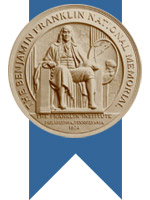Related Research Articles

Harold Eugene "Doc" Edgerton, also known as Papa Flash, was an American scientist and researcher, a professor of electrical engineering at the Massachusetts Institute of Technology. He is largely credited with transforming the stroboscope from an obscure laboratory instrument into a common device. He also was deeply involved with the development of sonar and deep-sea photography, and his equipment was used in collaboration with Jacques Cousteau in searches for shipwrecks and even the Loch Ness Monster.
Optica is a professional society of individuals and companies with an interest in optics and photonics. It publishes journals and organizes conferences and exhibitions. It currently has about 488,000 customers in 183 countries, including nearly 300 companies.

The Franklin Institute is a science museum and the center of science education and research in Philadelphia, Pennsylvania. It is named after the American scientist and statesman Benjamin Franklin. It houses the Benjamin Franklin National Memorial. Founded in 1824, the Franklin Institute is one of the oldest centers of science education and development in the United States. Its chief astronomer is Derrick Pitts.

The American Academy of Arts and Sciences (AAA&S) is one of the oldest learned societies in the United States. It was founded in 1780 during the American Revolution by John Adams, John Hancock, James Bowdoin, Andrew Oliver, and other founding fathers of the United States. It is headquartered in Cambridge, Massachusetts.

The Perkin Medal is an award given annually by the Society of Chemical Industry to a scientist residing in America for an "innovation in applied chemistry resulting in outstanding commercial development." It is considered the highest honor given in the US chemical industry.
The American Institute of Mining, Metallurgical, and Petroleum Engineers (AIME) is a professional association for mining and metallurgy, with over 145,000 members. It was founded in 1871 by 22 mining engineers in Wilkes-Barre, Pennsylvania, United States, being one of the first national engineering societies in the country. Its charter is to "advance and disseminate, through the programs of the Member Societies, knowledge of engineering and the arts and sciences involved in the production and use of minerals, metals, energy sources and materials for the benefit of humankind."
The IEEE Edison Medal is presented by the Institute of Electrical and Electronics Engineers (IEEE) "for a career of meritorious achievement in electrical science, electrical engineering, or the electrical arts." It is the oldest medal in this field of engineering. The award consists of a gold medal, bronze replica, certificate, and honorarium. The medal may only be awarded to a new leap/breakthrough in the technological area of science.

The IEEE Medal of Honor is the highest recognition of the Institute of Electrical and Electronics Engineers (IEEE). It has been awarded since 1917, when its first recipient was Major Edwin H. Armstrong. It is given for an exceptional contribution or an extraordinary career in the IEEE fields of interest. The award consists of a gold medal, bronze replica, certificate, and honorarium. The Medal of Honor may only be awarded to an individual.

The Franklin Institute Awards is an American science and engineering award presented by the Franklin Institute, a science museum in Philadelphia. The Franklin Institute awards comprises the Benjamin Franklin Medals in seven areas of science and engineering, the Bower Awards and Prize for Achievement in Science, and the Bower Award for Business Leadership. Since 1824, the institute has recognized "world-changing scientists, engineers, inventors, and industrialists—all of whom reflect Benjamin Franklin’s spirit of curiosity, ingenuity, and innovation". Some of the noted past laureates include Nikola Tesla, Thomas Edison, Marie Curie, Max Planck, Albert Einstein, Stephen Hawking. Some of the 21st century laureates of the institute awards are Bill Gates, James P. Allison, Indra Nooyi, Jane Goodall, Elizabeth Blackburn, George Church, Robert S. Langer, and Alex Gorsky.
Charles Gilbert Overberger was an American chemist, specialising in polymer research and education.
The Stuart Ballantine Medal was a science and engineering award presented by the Franklin Institute, of Philadelphia, Pennsylvania, USA. It was named after the US inventor Stuart Ballantine.

The John Price Wetherill Medal was an award of the Franklin Institute. It was established with a bequest given by the family of John Price Wetherill (1844–1906) on April 3, 1917. On June 10, 1925, the Board of Managers voted to create a silver medal, to be awarded for "discovery or invention in the physical sciences" or "new and important combinations of principles or methods already known". The legend on the first medal read: "for discovery, invention, or development in the physical sciences". The John Price Wetherill Medal was last awarded in 1997. As of 1998 all of the endowed medals previously awarded by the Franklin Institute were reorganized as the Benjamin Franklin Medals.
Prof Ernest George Coker FRS FRSE MIME MICE Wh.Ex. (1869–1946) was a British mathematician and engineer. He won the Howard N. Potts Medal for Physics in 1922, and the Rumford Medal for work on polarised light in 1936. He was an expert on stress analysis and Photoelasticity. He contributed to Encyclopædia Britannica and other works under the initials E.G.C.
References
- ↑ "Awards Program History". Franklin Institute.
{{cite web}}: Missing or empty|url=(help) - ↑ "Franklin Laureate Database - Howard N. Potts Medal Laureates". Franklin Institute. Archived from the original on May 2, 2014. Retrieved March 13, 2011.
- ↑ "Howard N. Potts Medal winners". Franklin Institute. Archived from the original on 2020-06-29. Retrieved 2015-02-27.
- ↑ "Potts Medal Goes to C.M. Foust". New York Times . September 16, 1951. Retrieved 2015-02-27.
The Franklin Institute announced today that a Howard N. Potts had been awarded to Clifford M. Foust ... high voltage surge phenomena ...